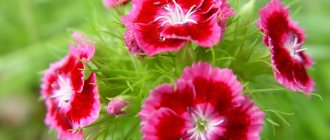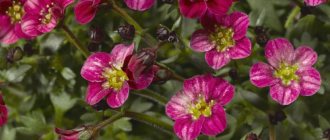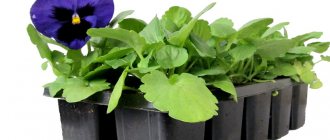Author: Elena N. https://floristics.info/ru/index.php?option=com_contact&view=contact&id=19 Category: Garden plants Published: February 15, 2019Last edits: April 24, 2021
- When to plant
- Growing conditions
Carnation Shabo (lat. Dianthus caryophyllus var. schabaud) is a herbaceous perennial of hybrid origin of the genus Carnation of the Carnation family. This hybrid form was obtained in the 19th century by the pharmacist Chabot from Toulon from crossing two types of cloves: Dianthus caryophyllus and Dianthus suffruticossus. In cultivation, this variety of garden carnation is grown for cutting and landscape design - ridges, mixborders, flower beds, as well as for decorating balconies, gazebos and terraces.
Planting and caring for Shabot carnations
- Flowering: from mid-summer to frost.
- Planting: sowing seeds for seedlings - from the second ten days of January to the third ten days of February, planting seedlings in open ground - in the second ten days of May.
- Lighting: bright sunlight.
- Soil: fertile, well-drained, neutral or slightly alkaline.
- Watering: regular, keeping the soil slightly moist at all times.
- Feeding: a week after planting - with nitrogen fertilizers, during the budding period - with nitrogen-potassium fertilizers. Mineral fertilizers can be applied to the carnation every 2 weeks, but it does not like organic fertilizers.
- Garter: tall varieties need to be tied to a support.
- Reproduction: most often by cuttings.
- Pests: thrips, mites, aphids.
- Diseases: fungal rot.
Read more about growing Shabot carnations below.
Use in landscape design
The Chabot beauty is a particularly favorite type of carnation for creative designers. Bright and graceful, at the same time very delicate, but unpretentious flower. In addition, Chabot is so different, it will fit perfectly into any floral picture (Figure 6).
Figure 6. Flower culture is actively used in landscape design
Low varieties can beautifully frame an island flower bed, or become part of mixborders; they are also widely used in wall-mounted and floor pots, which are placed on terraces and balconies. Alpine slides and rock gardens will also be happy to welcome such guests. Tall varieties can become worthy accents in the color composition of the landscape. From the neighbors we can recommend dark green coniferous plants. Against their background, our Shabo looks very advantageous.
Yes, this type of carnation will take a lot of your time and effort, but it will more than pay for itself with its long and fragrant flowering.
Detailed instructions for planting a flower are given in the video.
Botanical description
The height of the Shabot carnation is from 30 to 70 cm. Its root system is taproot, located at a depth of 10-20 cm. The shape of the bush is reverse pyramidal with a well-defined main stem. The shoots are bare, knotty, round, bluish-green in color. The leaves are also bluish-green, narrow, up to 12 cm long and up to 7 mm wide. Large flowers can be simple, double or semi-double, of various colors, folded, corrugated, curved or deeply dissected. Simple flowers usually have 10 stamens, while double flowers can have up to 30 or more. The fruit of the Shabot clove is a cylindrical multi-seeded capsule with five teeth, pointed at the end, in which small flat black seeds with a rough surface ripen.
Growing Turkish cloves from seeds
The perennial carnation Shabo in our climate is grown as an annual plant. We will tell you how to sow Shabot carnations for seedlings, how to care for seedlings, how to grow Shabot carnations in open ground, how and what to feed them, when to water them, when to pinch Shabot carnations and how to protect them from diseases and pests.
Growing Shabot cloves from seeds
How to sow seeds
To grow Shabot carnation seedlings, use a light neutral substrate, for example, a mixture of turf or garden soil, peat, humus and sand in a ratio of 2:2:2:1. Plastic containers, boxes, bowls, photo cuvettes or any other low containers with drainage holes are suitable as dishes. The optimal height of the container for seedlings should be no more than 5-6 cm, since deep containers increase the risk of excessive dampness in the substrate.
- Alstroemeria: growing in open ground
Shabo carnation seeds are sown for seedlings from the second ten days of January to the third ten days of February. Earlier sowing will require constant artificial lighting, and later sowing may push the flowering of carnations to the end of summer.
Shabot clove seeds do not need pre-treatment, but you can keep them in a solution of a growth stimulator - there will be no harm from this. Fill the seedling container with moist substrate, level the surface, being careful not to press the soil mixture too hard, and spread the Chabot clove seeds over the surface at a distance of 1 cm from each other. The seeds are sprinkled on top with a layer of calcined sand 3-4 mm thick - this measure will protect the seedlings from blackleg disease. Cover the crops with glass or film.
Seedling care
Shabot clove seeds require special conditions to germinate. The optimal temperature for this process is 15 ºC, but if your room is warmer, then place the crops as close to the floor as possible. Do not let the substrate dry out, but you need to ventilate the crops and remove condensation from the film daily, since Shabot carnation seedlings are very sensitive to rot. The substrate is moistened in the morning using a fine spray, as soon as the top layer of soil has dried.
Seeds will begin to germinate already on the 4-5th day, and the mass emergence of seedlings will begin a week after sowing. As soon as the first shoots hatch, the film is removed, the crops are moved to a southern windowsill and kept at a temperature of 12-13 ºC. Seedlings that are too long need to be supplemented with soil mixture. Monitor the development of the seedlings, and if they begin to stretch, provide them with artificial lighting for several hours a day. Do not forget to regularly ventilate the room without creating drafts. Watering should be sparse, keeping the soil slightly moist. Avoid over-watering!
Shabo carnation pick
Due to sowing too early, the Shabot carnation will need two pickings. The first picking is carried out in the phase of formation of a pair of true leaves. The seedlings are planted in separate cups or seedling cassettes with cells with a diameter of 4 cm. The second picking is carried out approximately at the end of March at the stage of full development of four pairs of leaves: the plants, together with a clod of earth, are transferred into pots with a diameter of at least 10 cm. With each picking, the level of seedling depth is maintained the same, and only if they are very elongated, deepen them no more than 2 cm.
When the seedlings have formed five pairs of leaves, the seedlings need to be pinched. If the plants look pale and grow very slowly, fertilize the seedlings on the leaves with low-concentration nitrogen fertilizers.
- Do you observe the 3 main conditions for planting bulbous flowers in the fall - timing, depth, pattern?
Immediately after the second picking, the Shabot carnation from seeds undergoes hardening procedures. The most popular way to adapt seedlings to cold is to lower the night temperature by 10 degrees. To do this, containers with seedlings are taken out into an unheated room overnight. When it gets warm, you can keep the seedlings under film in a greenhouse, unless, of course, there are night frosts. You can take the seedlings out into the garden in the sun during the day, away from the wind and drafts, and at night bring them into the greenhouse until the air temperature at night rises to 7-10 ºC.
Sowing
Sowing is done as follows: before planting clove seeds, the soil must be sifted and moistened, then the seeds should be spread out and sprinkled with calcined sand. After about seven days, the cloves will begin to germinate, subject to temperature conditions of eighteen to twenty degrees Celsius. After the seeds germinate, the seedlings should be transferred to a cool and well-lit room in which the temperature will not exceed twelve degrees Celsius. If the temperature drops, do not worry, the Shabot carnation is resistant to frost and should be planted in the ground as early as possible. If the seeds germinate unevenly, provide the hatching seedlings with more light, otherwise they will stretch out in anticipation of latecomers.
Carnation seedlings should not be watered, because they will begin to rot and their further growth will stop. And because of this, the seedling may simply die. It is also recommended to plant in a more illuminated area, because if they do not have enough light, they may simply die. If sluggish seedlings appear, they need to be removed, and the places where they grew should be sprinkled with sand.
Planting Shabot carnations in the ground
When to plant
Seedlings are planted in open ground immediately after the May holidays, without waiting for summer weather, since hardened Shabot carnation seedlings will not be damaged even by short-term frosts down to -3 ºC. The plant prefers sunny areas with fertile neutral or slightly alkaline soil. The Shabot carnation will not take root only in poor sand or heavy clay.
How to plant
The soil in the area for Shabot cloves is prepared in the fall: 45 g of phosphates and 20 kg of compost or humus per m² are added before digging. In spring, nitrogen and potassium fertilizers are applied to the soil at 15 g and 25 g per m², respectively. The procedure for planting seedlings is usual: pre-watered plants are transferred along with a lump of earth into planting holes, deepening the root system into the soil exactly to the same level at which it was before. That is, the root collar should remain above the surface. The feeding area of one plant is approximately 25x25 cm, which means that no more than 16 plants can be placed on one m² of land. After planting, the seedlings are watered.
Plant propagation by seeds
Although cloves are a perennial, they are usually grown as seedlings every year. The fact is that this species does not tolerate winter well, as a result of which flowering suffers. The most important thing is to sow cloves on time. This is usually done in the second half of January-first February.
Note: Moreover, in winter, do not forget about additional light! If you sow the seeds later, you risk seeing flowers only at the end of summer.
You need to plant it in a low container, it can be anything - containers, jars, boxes, cups, bowls. The main thing is not higher than 5 cm and with good drainage, otherwise high humidity will work against you. Containers can be pre-treated with potassium permanganate (Figure 3).
Prepare acid-neutral soil: one part each of turf, humus and peat, and half part sand. Or buy a ready-made mixture for seedlings - a universal neutral substrate.
Figure 3. The crop is propagated by seeds and cuttings
You can buy seeds or collect them yourself. Seeds of this species have a fairly high percentage of germination - 80-95%. They also last well (2-3 years), so you can buy them for future use. If we talk about collecting seeds on our own, it is not as easy to do as it seems. For the seeds to fully ripen, a warm, dry autumn is needed.
If your climate is different, then you will have to make additional efforts - bring the plants indoors or protect the place where the carnations grow in advance. Seeds ripen in approximately 40-60 days. It is easy to determine the maturity of the seeds - the box will open and the seeds will begin to spill out. Therefore, do not forget to tie them with cotton fabric first.
Caring for Shabot carnations
Growing conditions
Growing Shabot carnations is not an easy task. In order to get large flowers for cutting, you will have to invest a lot of work. How to grow Shabot cloves? You will need to perform the following procedures:
- regular watering to maintain light soil moisture;
- careful weeding and loosening of the soil after rains and waterings;
- adding fertilizers to the soil: the first time fertilizing is carried out with nitrogen fertilizers (ammonium nitrate, for example) at the rate of 15 g per m² a week after planting the seedlings in the flowerbed, the second time - during budding with ammonium nitrate at the rate of 10-15 g per m² and the same amount of potassium sulfate. Like all annuals, Shabot carnation does not like organic fertilizers, but mineral fertilizers can continue to be applied every 2 weeks;
- tying up shoots of tall varieties, which can fall due to rain or strong wind;
- Constant monitoring of the condition of plants and carrying out preventive measures to protect against diseases and pests.
Keep in mind that Shabot carnations cannot be grown in one place for more than two years, and try not to thicken the plantings.
Stepsoning
If you need large flowers for cutting, from the moment buds begin to form on the Shabot carnation until late autumn, you need to carry out pinching: all the buds and shoots are broken out of the axils up to the sixth node, so that the central bud develops into a large flower. The flowering of carnations can be prolonged by removing faded flowers in time. Carnations can bloom until late autumn, but with the onset of cool days, the buds will bloom more and more slowly, and the quality of the flowers will deteriorate.
Reproduction of carnation Shabo
Since carnations are easily cross-pollinated, the seed propagation method when using personally collected seeds may not give the expected result, since it does not guarantee the preservation of the characteristics of the variety. That is why it is better to dig up a plant you like in the fall, shorten its shoots, move it to a cool room for the winter, and in the spring cut cuttings from the middle part of the shoots of the mother bush.
- Medicinal garden plants and flowers (part III)
The lower cut at the internode is made oblique, treated with Kornevin or another root formation stimulator, and the cuttings are planted in wet sand. Leave only the top leaves on them and remove the bottom ones. Cover the cuttings with a clear dome or glass jar to create a greenhouse effect. Ventilate the cuttings daily, moisten the sand as necessary, and in three weeks the cuttings will grow roots, and soon bushes will form. Cuttings are the only way to preserve all the varietal characteristics of the Shabot carnation.
Pests and diseases
With proper and timely care, the Shabot carnation rarely gets sick, but during rainy, stuffy seasons it can be overcome by fungal diseases. Plants severely affected by infection must be removed from the site, and the remaining bushes should be treated with copper-containing fungicides - Hom, Kuproxat, Bordeaux mixture or similar preparations.
Among the pests that can harm carnations are sucking insects - thrips, mites, aphids. They bite through the above-ground parts of the plant and feed on cell sap, as a result of which flowers, leaves and shoots begin to lag behind in development, become deformed, and the plant loses its attractiveness. In addition, sucking insects are carriers of incurable viral diseases. If there are few pests, you can deal with them with an infusion of onion peels, garlic, a solution of tar or laundry soap, but if the occupation is significant, then you will have to resort to treating the cloves with solutions of insectoacaricides - Actellik, Aktara or Karbofos.
Diseases and pests
Shabot carnation is extremely rarely affected by diseases and pest attacks. But if the weather is too rainy and stuffy, fungal diseases may begin to develop. To prevent the disease from spreading, it is necessary to remove the affected plants and carefully treat the rest with special solutions.
As for pests, aphids, mites and thrips love to eat cloves. They suck the juice out of the plant, causing the plant to become deformed and become less beautiful and attractive. Pests are also a variety of viral diseases, so they must be gotten rid of without fail. To do this, you need to treat the clove bushes with special insectoacaricides.
Carnation Shabo at home
The Shabot carnation is not a suitable flower for indoor cultivation: it is not for nothing that it is called garden carnation. However, with the onset of cold weather, the Shabot carnation can be dug up, planted in a pot and brought indoors, where it will bloom until mid-November, or even longer. But it will require from you approximately the same conditions under which seedlings are grown: cool conditions and very bright lighting. In spring, the overwintered mother plant can be used for cuttings.
In indoor culture, it is better to grow Chinese, hybrid and even Turkish carnations, and Shabot and Grenadines, with the exception of some varieties, are plants for the garden.
When will the shoots appear?
With proper sowing and favorable conditions, the first shoots appear on the 5-6th day, the seeds germinate completely on the 8-10th day. The emergence of sprouts may be delayed at air temperatures above +21°C. With the emergence of seedlings, the cover from the microgreenhouses is removed and the containers are placed in a well-lit place.
Shabo carnation varieties
The most famous varieties of Shabo cloves are:
- Legien D'Honaire is a plant with dark cherry-red flowers;
- Girofle – purple carnation;
- Marie Chabot - a plant with yellow flowers;
- Jeanne Dionysus - carnation with white flowers;
- Aurora - a variety with salmon-pink flowers;
- varieties Foyer Koenig and Etinselyan - varieties with red flowers;
- variety Mikado – carnation with purple flowers;
- Ruby - dark red carnation;
- Fire King is a carnation with bright red flowers with an orange tint;
- Pink Queen - a variety with bright pink flowers;
- La France - carnation with light pink flowers;
- Benigna - light purple flowers with a purple border;
- Nero - dark red velvety flowers that do not fade in the sun;
- Mont Blanc - fragrant white carnation;
- Champagne is a variety with yellowish flowers.
The series of varieties Pikoti, Giant Terry, Aquarelle, Disco, Lyon, as well as the series of hybrids Luminet Mixt and Night Series Mixt of various colors and colors have proven themselves well.
In modern hybrids, the time period from germination to flowering is half as long as in long-bred varieties, so they can be planted not in February, but in March, when the daylight hours are already long enough and you do not have to provide artificial lighting for the seedlings. Hybrid plants bloom all summer, and compact varieties with a stable stem are used for landscaping balconies and flower beds. Some of them can even be grown indoors.
Brief information about the plant
Bred in the 19th century by the French pharmacist Chabot from Toulon, carnations, thanks to their natural beauty, duration and abundance of flowering, very quickly gained popularity not only in Europe, but throughout the world. Retaining its freshness for a long time after cutting, it has become a favorite flower when arranging bouquets.
Surprisingly, the fragile and delicate flower has become a model of severity and solemnity. Not a single festive event is complete without these flowers. And the red carnation serves as a symbol of courage and bravery, and is the personification of victory.











